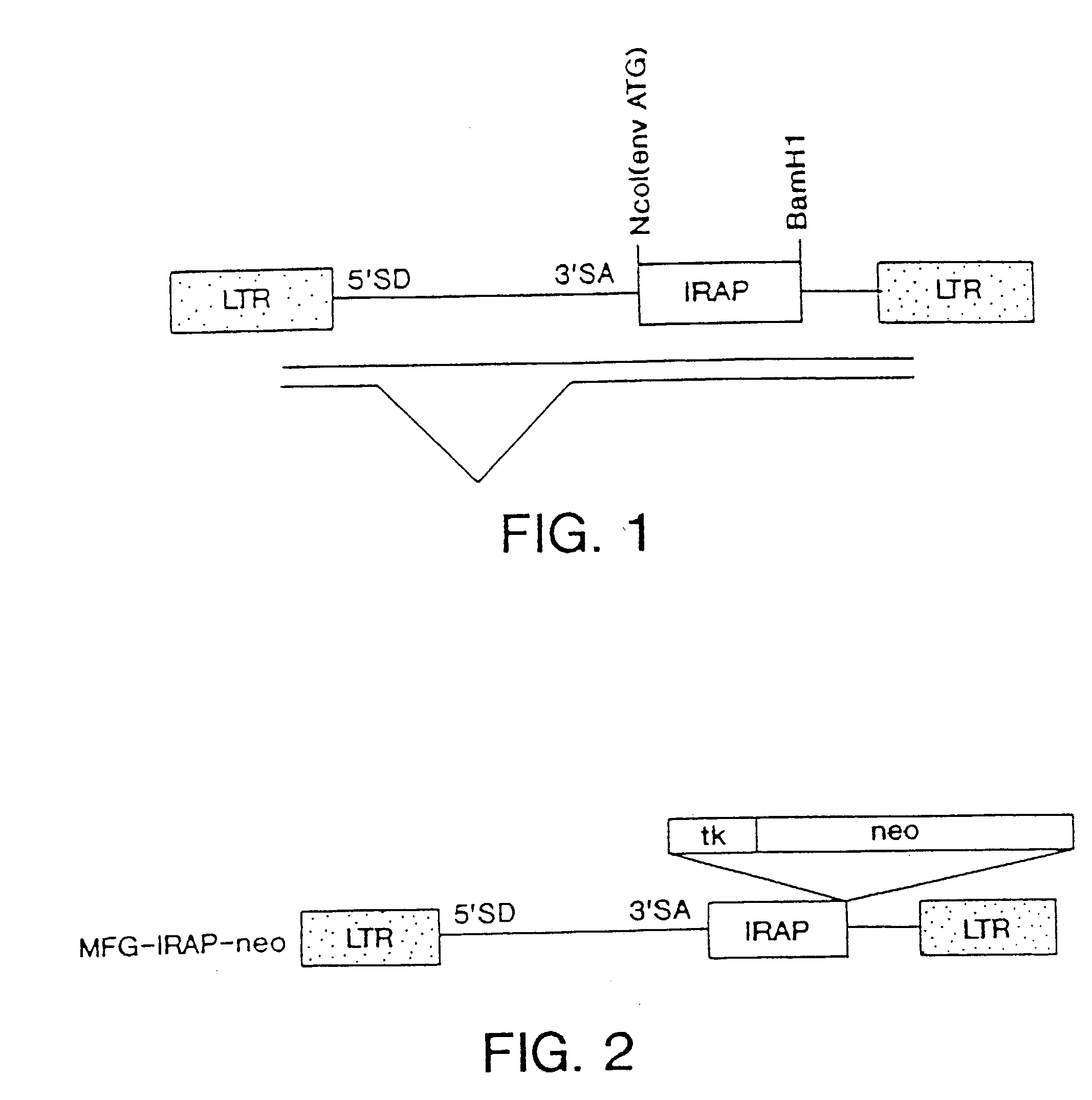Gene transfer for treating a connective tissue of a mammalian host
a technology of connective tissue and gene transfer, which is applied in the direction of biocide, drug composition, peptide/protein ingredients, etc., can solve the problems of affecting the therapeutic intervention of arthritis, and affecting the effect of the target molecule siz
- Summary
- Abstract
- Description
- Claims
- Application Information
AI Technical Summary
Problems solved by technology
Method used
Image
Examples
example i
[0160] Packaging of AAV
[0161] The only cis-acting sequences required for replication and packaging of recombinant adeno-associated virus (AAV) vector are the AAV terminal repeats. Up to 4 kb of DNA can be inserted between the terminal repeats without effecting viral replication or packaging. The virus rep proteins and viral capsid proteins are required in trans for virus replication as is an adeno-associated virus helper. To package a recombinant AAV vector, the plasmid containing the terminal repeats and the therapeutic gene is co-transfected into cells with a plasmid that expresses the rep and capsid proteins. The transfected cells are then infected with adeno-associated virus and virus isolated from the cells about 48-72 hours post-transfection. The supernatants are heated to about 56.degree. Centigrade to inactivate the adeno-associated virus, leaving an active virus stock of recombinant AAV.
example ii
[0162] Electroporation
[0163] The connective tissue cells to be electroporated are placed into Hepes buffer saline (HBS) at a concentration of about 10.sup.7 cells per ml. The DNA to be electroporated is added at a concentration of about 5-20 ug / ml of HBS. The mixture is placed into a cuvette and inserted into the cuvette holder that accompanies the Bio-RAD electroporation device (1414 Harbour Way South, Richmond, Calif. 94804). A range between about 250 and 300 volts at a capacitance of about 960 ufarads is required for introduction of DNA into most eukaryotic cell types. Once the DNA and the cells are inserted into the Bio-RAD holder, a button is pushed and the set voltage is delivered to the cell-DNA solution. The cells are removed from the cuvette and replated on plastic dishes.
example iii
[0164] The cDNA encoding the human interleukin-1 receptor antagonist (IRAP) was inserted into the NcoI and BamHI cloning sites of the retroviral vector MFG as shown in FIG. 1. Specifically, a Pstl to BamHI fragment from the IRAP cDNA was linked to a synthetic oligonucleotide adapter from the NcoI site (representing the start site of translation for IRAP) to the Pstl site (approximately 12 base pairs downstream from the NcoI site) to the MFG backbone digested at NcoI and BamHI in a three part ligation reaction. This three part ligation involving a synthetic oligo and two DNA fragments is well known by those skilled in the art of cloning. LTR means long terminal repeats, 5'SD means 5' splice donor, 3'SA means 3' splice acceptor. The straight arrow and the crooked arrow in FIG. 1 represent unspliced and spliced messenger RNAs respectively. IRAP is encoded by the spliced message.
[0165] FIG. 2 shows the cDNA encoding the human interleukin-1 receptor antagonist protein (IRAP) with a selec...
PUM
| Property | Measurement | Unit |
|---|---|---|
| concentration | aaaaa | aaaaa |
| time | aaaaa | aaaaa |
| pore size | aaaaa | aaaaa |
Abstract
Description
Claims
Application Information
 Login to View More
Login to View More - R&D
- Intellectual Property
- Life Sciences
- Materials
- Tech Scout
- Unparalleled Data Quality
- Higher Quality Content
- 60% Fewer Hallucinations
Browse by: Latest US Patents, China's latest patents, Technical Efficacy Thesaurus, Application Domain, Technology Topic, Popular Technical Reports.
© 2025 PatSnap. All rights reserved.Legal|Privacy policy|Modern Slavery Act Transparency Statement|Sitemap|About US| Contact US: help@patsnap.com



